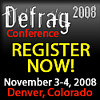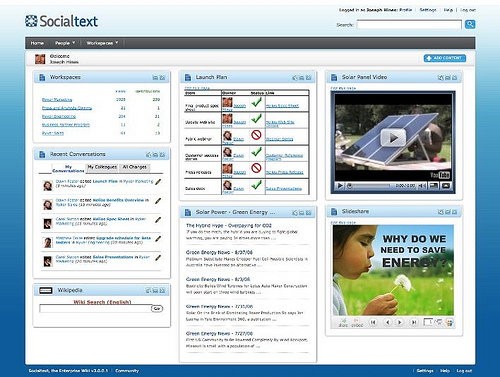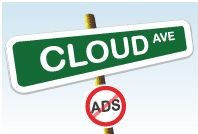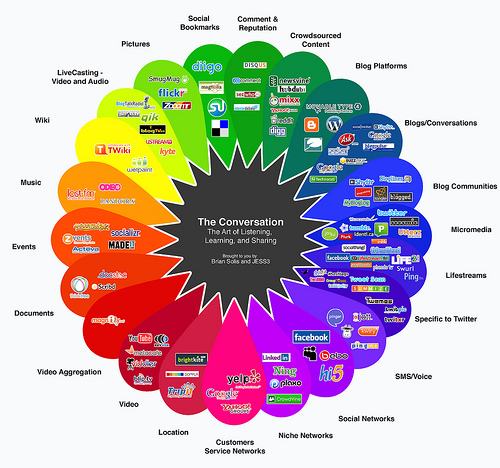So I’m cutting off Spoke Software who sent me this piece of junk: If you want to keep your job, use Spoke.

I Hate Fear Marketing

Come to Defrag
 Next week I’ll be in Denver, attending Defrag, a boutique, intellectual, intense, very participatory conference. I’m attending despite the fact that I’ve cut down on conference attendance, not because of the current economic turmoil, but largely due to burnout. After a while they just all feel the same: empty session rooms, bored exhibitors, people just enjoying ad-hoc hallway conversations. But there is something intriguing about Defrag: friends and smart minds I respect keep on tweeting about Defrag, and the agenda just looks exciting.
Next week I’ll be in Denver, attending Defrag, a boutique, intellectual, intense, very participatory conference. I’m attending despite the fact that I’ve cut down on conference attendance, not because of the current economic turmoil, but largely due to burnout. After a while they just all feel the same: empty session rooms, bored exhibitors, people just enjoying ad-hoc hallway conversations. But there is something intriguing about Defrag: friends and smart minds I respect keep on tweeting about Defrag, and the agenda just looks exciting.
- I’ve always enjoyed reading Paul Kedrosky, whose posts deliver the punch in just a few words – or an image. I’ve never met him, so I’m looking forward to his keynote.
- Howard Lindzon’s keynote, titled It’s Always a Good Time to Start a Web Business will no doubt have a very special meaning in the current economic situation.
- I’m really, really looking forward to the next keynote, Getting Into the Flow Applications – a subject I somewhat touched upon, and likely will re-visit before heading to the conference.
- The first breakout session will be a huge dilemma: I literally should split myself in two halves, I badly want to attend both Dis (and Re)-aggregating the Web with Disqus, Intense Debate and my6sense, but I can’t miss Re-imagining the metaphors behind collaborative tools with Atlassian, Mindtouch, Liquid Planner, One Place either. (Update: now I really can’t miss it, as I’ll be moderating this session.)
I could go on, but I’ve just realized I’d literally have to duplicate the entire Agenda here. Have I just discovered Defrag’s secret sauce? Conferences are never about sessions, it’s all about the ad-hoc networking, even lobbycon-ing – yet I find myself wanting to attend most sessions, in fact two of them in most of the breakouts. Defrag promises amazing intellectual content, and if I just follow Twitter, an extraordinary group of innovators plan to attend. From what I hear, this is the conference where the attendees participate just as much as the speakers.
Do yourself a favor, check out the Agenda, read Eric’s 10 reasons to come to Defrag and register. (Use discount code “zoli1” to receive $300 off).
Update: Microsoft’s PDC is in full force today, and guess what, the conference wi-fi is failing. This seems to be the fate of all conferences, including ironically Web 2.0 Expo. The only exception I’ve seen so far is the Office 2.0 Conference, which teamed up with Swisscom to build rock-solid wi-fi. What is less known though, that they got the tip and contacts from Defrag organizer Eric Norlin. Yes, Defrag, working with Swisscom was the first conference to provide industrial-strength, reliable wi-fi throughout the entire site, including rooms in the conference hotel, the Hyatt Regency. So if you come to Defrag, you’ll be connected 24/7. (OK, just 24/2: Nov 3-4th )
)

SocialText Becomes Really Social
Socialtext, the enterprise wiki company is no more… a wiki company, that is. Not since Socialtext 3.0, the new release announced today. Founder and Chairman Ross Mayfield calls his new baby a Connected Collaboration Platform, that’s modular, built on a widget framework, and consists of:
- Socialtext Dashboard – your Communication Central
- Socialtext People – Facebook for the Enterprise
- Socialtext Workspace – originally known as the wiki

A fourth piece, Socialtext Signals is in the works, in private beta testing – I guess we could call it Twitter (Yammer? ESME?) for the Enterprise. Actually more, since it involves active microblogging – quick messages – as well as pulling in what users do elsewhere (FriendFeed?)
The platform is flexible, easy to customize via widgets, clearly the vision is that in an enterprise environment actionable information is pulled in from the transactional systems, too – i.e. ERP, CRM.
Knowing Ross as the uber-social guy something tells me this is what he always wanted to to: create Social Software. But I tend to agree with Jevon MacDonald, who differentiates social software from the wiki, which is primarily a collaboration tool. So Ross was really in the collaboration business and given his name became synonymous with wiki evangelism, he will no doubt have a hard time changing that image. 
This is not to say the wiki part, should be neglected… It is the primary collaboration facility for anything not well handled by process-driven, transactional systems, and all this social layer is just the glue that holds it all together. (Hint: you will hear a lot more about Glue soon).
I had in the past been quite critical of Socialtext’s wiki component, and am looking forward to revisit it, as part of our wiki-series in the coming weeks @ CloudAve. In the meantime, enjoy this video:
Related articles by Zemanta
- SocialText 3.0 blends Facebook, Twitter, and the Enterprise
- Hello Socialtext 3.0!
- Socialtext 3.0: Will Wikis Finally Find Their Place in Business?
- Social(er)text: From Wiki to Wonderkind


Twitter Romance?
you know you are all grown up when you are purchasing your first very own toilet scrubber.
about 7 hours ago from web
Teresa Wu
And the response:
@resawu I’ve since purchased two toliet scrubbers along my path to adulthood. I think I’m pretty much ready for children now
about 7 hours ago from TweetDeck in reply to resawu
Daniel Ha
Well, it wouldn’t be the first one 🙂
Update: Toilet’s indeed play an important role in a startup’s life.

Wallop – Walflop
Two years ago I called it Walflop. Finally, Microsoft spin-off Wallop entered the deadpool, reports TechCrunch.

CloudAve Launched – and Thank You, Harry
 (OK, I sinned. Mea Culpa. I’ve just cross-posted an entire article, which is not the best behavior. But it’s not every day that I launch a new group blog – so consider this my shameless self-plug, and please subscribe to the feed.
(OK, I sinned. Mea Culpa. I’ve just cross-posted an entire article, which is not the best behavior. But it’s not every day that I launch a new group blog – so consider this my shameless self-plug, and please subscribe to the feed. )
)
We must be a crazy bunch on a suicide mission. Why else would we launch a new blog focused on Cloud Computing and Business, when it’s just a fad that will collapse in two years?
Harry Debes, CEO of Lawson Software is a respected Enterprise Software industry veteran, but I’m afraid for all his achievements he’ll go down in history as the man who grabbed headlines with a fatally wrong call. Of course not all wrong calls hurt one’s reputation: IBM’s Thomas Watson is still an industry legend despite the famous quote incorrectly attributed to him:
” I think there is a world market for maybe five computers“
The small difference is that what Thomas Watson could not fathom in 1943 ended up putting IBM on an amazing growth trajectory, while Harry Debes’s view may just turn out to be fatal for Lawson – or to quote my Enterprise Irregular friend, Vinnie Mirchandani:
“That’s what American and Delta said about SW. And GM and Ford said about Japanese cars. And Sears and Wards said about WalMart.”
Another quote by Vinnie, closer to our industry:
“Dun & Bradstreet, which GEAC acquired for a song, was one of the most spectacular slides in the software market. In less than 5 years it went from dominant position to a distress sale as it missed the client/server wave in early 90s.”
I’ve seen that one close, fortunately for me from SAP’s side – the winner in that round. We’re witnessing another tidal wave now, the shift to Cloud Computing. It won’t happen overnight, but those who completely ignore it will vanish. Some of my fellow Enterprise Irregulars elaborate more:
- Vinnie Mirchandani points out that SaaS is what more and more customers want, and those who stop listening to customers inevitably hit the wall sooner or later. Need proof? How about this 100% SaaS customer, showcased at the recent Office 2.0 conference?
- Jim Berkowitz of CRM Mastery fame agrees, adding that calling people, potential customers “stupid” never leads to any good.
- Bob Warfield makes the case that even if we ignore what customers want and only consider profitabilty, Debes is wrong, Salesforce.com is almost as profitable as Lawson, but grows much faster, while Conquer, another SaaS success story is actually more profitable than Lawson is.
- Jason Corsello adds that Lawson actually launched a SaaS offering last year, but experienced lackluster customer response largely to pricing and deployment issues … so now that they couldn’t pull it off, the declare the entire market doomed.
- Josh Greenbaum concludes: “SaaS isn’t collapsing, it’s only just getting started“.
I can live with that… it’s only starting… so we’re not a suicidal bunch, after all. But thank you, Harry Debes, for sparking a great discussion.
But thank you, Harry Debes, for sparking a great discussion.
If you read just the few articles I’ve quoted above, you get a fairly good picture of the many benefits the Software as a Service model offers. Let me add a few of my personal favorites:
- Extended reach – small businesses can now have business functionality previously only available and affordable for large enterprises.
- Commoditization of the software market – commoditization hurts most companies, except the few who drive it, but guess what – it’s great for customers.
- End of Bloatware – for the first time SaaS vendors can run stats and observe what features are actually used by customers, so they can cut out the fat and enhance the in-demand features.
- New Business Models, like benchmarking – based on anonym aggregate data provide your customers with performance metrics. Even newer business models we have not even imagined yet.
- Dramatically changed Sales and Marketing model: pull vs. push. Instead of the traditional sales model it’s all about transparency, information, letting informed customers find you. The Product sells itself and your Customers are your Marketing team.
We’ll be writing about these and more. I’m a “business application guy”, so I mostly talk about SaaS – but our name is Cloud Avenue, not SaaS Avenue, for good reason: fellow blogger Krish will talk about it soon. By the way, Krish and I got to know each other through our blogs – just like my fellow Editor, Ben Kepes, and just about all other contributors. We also have our CloudLab – for product / service reviews. Yes, we will report on products, but do not strive to be a mini-TechCrunch: we have no intention to report about everything new. We’re not a news-blog. We’d rather sit back, analyze a market, find key players, then produce a series of reviews / comparative analysis. Quality before quantity or urgency.
We’re believers in Cloud Computing, but not over-zealous cheerleaders. Just as I’m finishing this post, another SaaS debate erupted, which prompted Anshu Sharma to note: “there must be a Sky is Falling Support Group“. The really notable part of the Cloud-Filled Debate @Forbes is Nick Carr’s responses: not because of the Big Switch author’s unquestionable “cloud-bias”, but because of how realistic he is:
Forbes.com: Is cloud computing over-hyped?
Nicholas Carr: At the moment, yes, and that’s typical for technological advances.What’s your imagined time line of the adoption of cloud computing? Will it take years? Decades?
If you’re talking about big companies, I would say it will be a slow, steady process lasting maybe 15 to 20 years.On what Gartner Research analysts call “the cycle of hype and gloom,” where do you think cloud computing is currently positioned?
It’s definitely near the peak of its hype. The doom period, when the media and IT managers realize the challenges ahead, is likely coming soon. But regardless of hype or gloom, the technology will only keep progressing.
Overhyped, slow process, doom is coming… has Nick Carr switched sides? No, he is just being realistic – and that’s what we need to do here @CloudAve, too. We will talk about integration problems, security issues, privacy concerns, even legal ramifications – many of these I don’t claim to know much about, which is why it’s great to have a diverse team of authors with complementary areas of expertise. And our door is never closed: we welcome guest posts, and who knows, you may feel inclined to join us as as a regular writer…
Finally, we could not afford to bring you CloudAve without sponsorship. My regular readers know I’ve been an advisor to Zoho for years now – I’ve found them to be a showcase for a lot of my ideals. Zoho stepped up as exclusive sponsor of CloudAve. This does not make us a Zoho PR outlet, in fact they can expect less coverage here than they got on my personal blog. We enjoy complete editorial independence.
What we do not have, and will not have is any form of advertising. None of those flashy banners, boxes, making the site close to unreadable. Just pure content. And since we are not dependent on page views, we can afford to offer our content under a Creative Commons licence. Yes, it’s all yours, take it – just don’t forget attribution.
So here we are – welcome to CloudAve. We hope you will follow us. And once again, thank you, Harry, for all the attention to Cloud Computing.
 P.S. The CloudAve platform is not exactly in nice order yet. It’s work-in-progress.
P.S. The CloudAve platform is not exactly in nice order yet. It’s work-in-progress.
So for now, all I can do is apologize for the shabby appearance, like I did at a previous move – that one turned out quite well, didn’t it?
And talk about move – I am not abandoning this blog either, so I hope you continue to follow me both here and on CloudAve.

Project Management 2.0 – What’s Wrong With 1.0?
Let me quickly state that I don’t really know what the consensus definition of PM 2.0 is, but I do have a feeling based on my very 1.0-style experience.
In the 90’s I worked on a number of fairly large scale SAP Projects in a variety of roles, including Project Manager, and supervisor of several other projects. The standard tool was Microsoft Project. It was used for:
- Planning a Project (initial Scoping)
- Selling it
- Periodic reporting to Steering Committee during the actual projects
What’s missing from the above? Well, how about using it to help the actual daily work of project team members?
Project team members did not even have access to MS Project, it only existed in a few copies on the PM and Team Lead’s computers. Information-flow was one-way: feed the beast to be able to occasionally print charts that look impressive (scary) enough that Steering Committee members won’t question it.
Ok, I am admittedly sarcastic, but the point is: PM 1.0 was all about planning, reporting and it served Management but did not help actual Project Execution.
My expectation of PM 2.0 would be that it helps all team members involved who can share information, collaborate on it and actually get clues from the system on where they are, where they should be, what their next step is, instead of just feeding the beast.
Is this the real promise of Project Management 2.0? I hope to find out from an excellent set of panelists that I have the honor of moderating at the Office 2.0 Conference next week:
- Andrew Filev (Wrike)
- Bruce Henry (LiquidPlanner)
- Mark Mader (Smartsheet.com)
- Guy Shani (Clarizen)
- Dean Carlson (Viewpath)
Of course this is just one of many exciting sessions – if you haven’t registered yet, you can grab a $100 discount by registering here. Oh, and don’t forget to visit us at the Zoho Party – the address is #1 Cloud Avenue. 
(This article is cross-posted at the Office 2.0 Conference Blog)

How Brian Solis Invented the Conversation Prism
First I really could not imagine how PR Maven Brian Solis came up with the Conversation Prism: Chrysanthemum: (clarification by Susan Scrupski)

But then I got enlightened by fellow Enterprise Irregular Brian Sommer, who introduced me to the creative process:
Creating A Stop Sign – Watch more free videos
Related articles by Zemanta

LA Earthquake: Twitter Reports First – Again. Fake Video Caught.
Google thinks I am an earthquake expert simply because I pointed out Twitter was the first to report the recent earthquakes in Japan and China.
Today the same happened: Twitter was on fire with user reports of the Los Angeles earthquake 9 minutes before the first AP wire came out.

It’s an undeniable trend – but is it important?
I received some flak in comments to the previous two posts, for neglecting to mention that I was comparing apples to oranges. New agencies have the responsibility to verify information and it takes time. Reliability over Speed. Fair enough. ReadWriteWeb asked the question: Did Twitter Really ‘Outshine’ the Mainstream Press?
The only thing Twitter does better than the traditional news is speed. It doesn’t do depth, it doesn’t do fact-checking, it doesn’t do real reporting. It does breaking news, and it does that very well — in many cases these days better than the mainstream press (in terms of how fast it breaks news).
Very well said, and I think we need both: speed and depth. Ironically, MG Siegler’s post @ VentureBeat describing twitter’s power in such situations provided an example for the opposite by including what appeared to be the very first video footage of the LA quake.
I watched it without sound first, but was immediately suspicious:
I wonder what this video shows. It’s NOT the building shaking. The movement is too fast, and it’s inside the room, relative to the window frames we see. It looks more like a camera quickly moved left and right.
If this was an indication of how the building moved, we’d see a lot less movement behind the window (inside) and a lot more outside.
It did not take long to get confirmation on Venturebeat:
Update 2: The 12seconds vid was fake, posted after the fact, a co-founder of 12seconds confirmed.
So there you have it. People do take advantage of the relative naivete of social media and don’t hesitate to post fake news to gain 5 minutes of fame. But that doesn’t undermine the importance of speed, which in some cases can provide early alerts and potentially save lives. We need both.
Related posts: CNET News.com, Twitter Blog, Valleywag, Brij’s One More Idea , RexBlog.com, LA Times blog, Live Digitally.

Bounce or Not, Twitter Still Only Crawls
 Twitter gets its sexy back – reports VentureBeat. Twitter Bounced Back! [I Toldja So] – says Mashable.
Twitter gets its sexy back – reports VentureBeat. Twitter Bounced Back! [I Toldja So] – says Mashable.
Yes, we stick around, waiting for Twitter to get up from its deathbed. And for I while it looked like it’s pulse was coming back. But today it’s down to 20 API requests again. This means Twhirl and other clients can check it once every 8-10 minutes. That’s so slow, you just completely lose the rhythm. The occasional batch updates bring in way too many messages that immediately scroll down, and you don’t feel like responding: in twitter-time 20 minutes are too long. So client use is out of question, and who wants to keep refreshing the web-page?
For now, Twitter is still dead.





Recent Comments